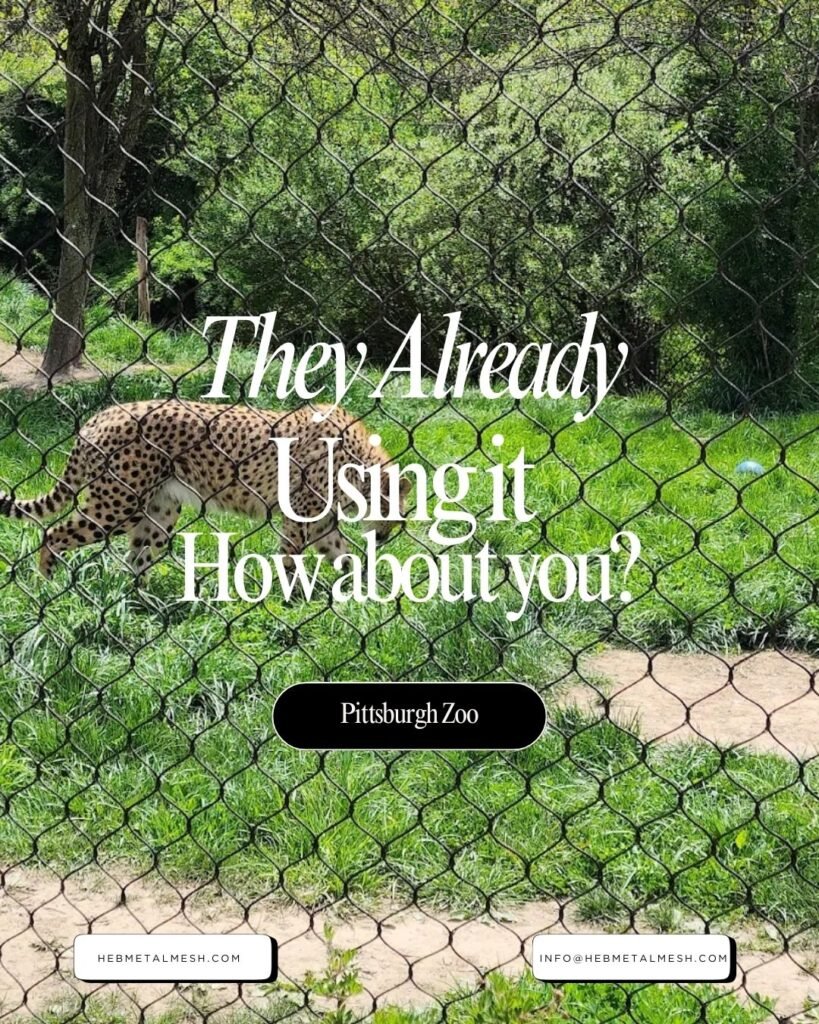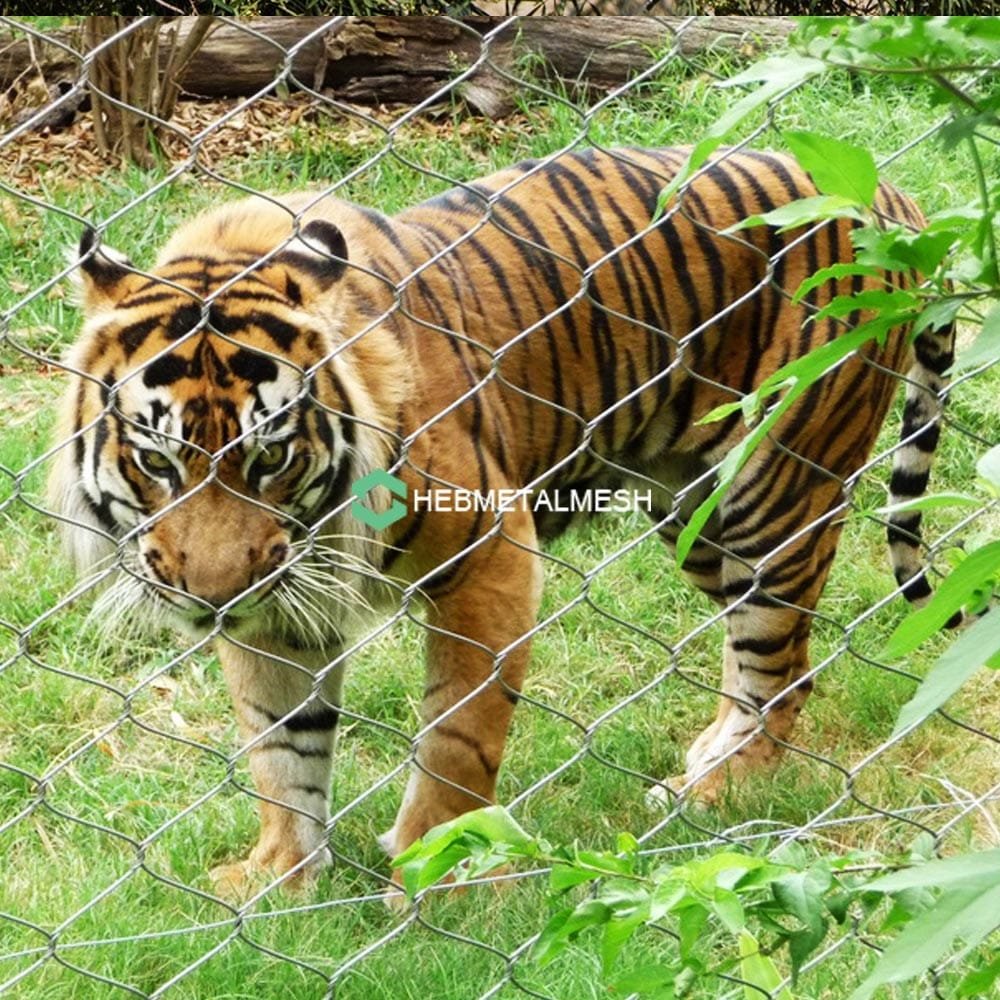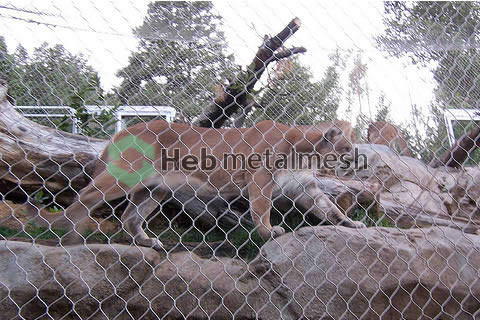Durable and Secure Zoo Enclosure Fencing for Wildlife Safety
High-quality zoo enclosure fencing is essential for ensuring animal safety, visitor protection, and habitat aesthetics. HEBMetal Mesh specializes in manufacturing robust stainless steel mesh fences designed to withstand harsh environments while providing unobstructed visibility. These enclosures meet international zoo safety standards, offering corrosion resistance, strength, and flexibility for diverse species—from small primates to large predators.
For guidelines on zoo enclosure design, refer to the Association of Zoos & Aquariums (AZA) (AZA Habitat Design Standards) or the World Association of Zoos and Aquariums (WAZA) (WAZA Animal Welfare). With customizable solutions, HEBMetal Mesh supports zoos, wildlife parks, and conservation projects in creating ethical and secure habitats.
Introduction to Zoo Enclosure Fences
When it comes to designing effective animal habitats, the choice of a zoo enclosure fence plays a pivotal role in ensuring both the safety of the animals and the enjoyment of visitors. Zoo fences serve as physical barriers that protect wildlife from external threats while simultaneously preventing animals from escaping into the public space. Among the myriad of materials utilized for these enclosures, the selection of the right fence material can significantly influence not only the enclosure’s safety and functionality but also its aesthetic appeal.
In today’s standards for animal welfare, it is essential that a zoo enclosure fence not only secures the inhabitants but also promotes their well-being by allowing for natural displays of behavior. Robust design features often contribute to a visually pleasing environment, making it imperative for zoos to carefully assess their options. The materials chosen must withstand the challenges posed by environmental elements, animal interaction, and human activities.
Common materials for zoo enclosure fences include chain link, wood, glass, and the increasingly popular handwoven stainless steel netting. Each of these materials comes with its unique advantages and drawbacks. For instance, chain link is known for its strength and cost-effectiveness but may lack the visual appeal desired in a more naturalistic setting. Conversely, glass panels offer unobstructed views, yet they may require extensive maintenance and present some safety concerns regarding impact. Handwoven stainless steel netting stands out due to its blend of durability, flexibility, and aesthetic appeal, making it a preferred choice for modern zoo enclosures.
Ultimately, understanding the critical factors that underlie the selection of a zoo enclosure fence is essential for achieving a balance between functionality, safety, and visual design. This awareness will guide zoo planners in creating environments that are not only secure but also captivating for all who visit.
Factors to Consider When Choosing a Zoo Enclosure Fence
When selecting a zoo enclosure fence, various factors come into play, each contributing to the overall effectiveness and appeal of the structure. First and foremost, durability is paramount. A fence must withstand diverse weather conditions, interaction from animals, and potential vandalism. Stainless steel netting is often chosen for its exceptional strength and resistance to rust, ensuring longevity even in challenging environments. Moreover, selecting a fence material that can endure the rigors associated with an active zoo is crucial to protecting both animals and visitors.
Maintenance constitutes another critical factor when choosing a zoo enclosure fence. The chosen material should not only be durable but also easy to maintain. Stainless steel, compared to other materials, requires minimal upkeep, helping to reduce long-term operational costs. It is essential to consider how often the fence will require cleaning and any repairs that might arise from wear and tear, especially for high-traffic areas.
Visibility is another consideration that plays a significant role in the enjoyment of zoo visitors. An enclosure fence should provide a clear view of the animals without compromising their safety. Handwoven stainless steel netting offers excellent visibility while ensuring that the animals are secure within their respective habitats. Transparency in the fence design provides an unobstructed view, enhancing the visitor experience while allowing for safe containment.
Furthermore, the specific needs of different animal species must be considered. Some animals might require a higher level of security due to their size or temperament. Understanding these unique requirements is essential in developing an appropriate fence solution. Finally, aesthetics should not be overlooked, as an appealing design can enhance visitor engagement and reflect the zoo’s commitment to creating an enriching environment for both animals and guests.
Introduction to Hebmetalmesh
Hebmetalmesh stands out in the field of manufacturing high-quality handwoven stainless steel netting, with over 20 years of experience. Located at the intersection of innovation and precision, the company has built a reputation for itself as a trusted provider of enclosures suitable for various applications, including zoo enclosure fences. Their commitment to quality craftsmanship is evident in every product, which is meticulously designed to meet the unique demands of their clientele.
Throughout its two-decade journey, Hebmetalmesh has consistently focused on refining and enhancing its manufacturing processes. The brand is synonymous with durability and strength, making their handwoven stainless steel netting an ideal choice for demanding environments, such as animal enclosures and other protective applications. Their expertise in creating robust yet aesthetically pleasing zoo enclosure fences allows them to cater to zoos and wildlife parks that prioritize both safety and visual appeal.
Moreover, Hebmetalmesh prides itself on its innovative approaches, integrating the latest technology into its production methods. This not only ensures that the final products are of the highest quality but also positions them at the forefront of industry advances. Their netting solutions are designed to withstand harsh weather conditions and the inherent challenges associated with animal behavior while maintaining the integrity and safety of the enclosure. By focusing on these key aspects, Hebmetalmesh has solidified its place as an essential player in the market for zoo enclosure fences.
In addition to their manufacturing prowess, Hebmetalmesh is highly attentive to customer needs, offering extensive support throughout the purchasing process and beyond. This dedication to client satisfaction cements their status as a reliable partner for institutions looking to enhance their animal habitats and viewing experiences. As the demand for effective and durable enclosure solutions continues to rise, Hebmetalmesh remains poised to lead the way.
Benefits of Handwoven Stainless Steel Netting
Handwoven stainless steel netting is increasingly recognized as a superior choice for zoo enclosure fences. One of the primary advantages of this material is its impressive durability. Unlike traditional fencing materials, handwoven stainless steel netting is designed to withstand harsh environmental conditions, including extreme weather and potential wear from animals. This durability assures zoo operators of a low maintenance requirement over time, thus reducing long-term operational costs significantly.
In addition to its robustness, handwoven stainless steel is inherently resistant to corrosion. This feature is particularly important in outdoor settings, where fences are exposed to moisture and other harsh elements. The corrosion resistance not only prolongs the lifespan of the zoo enclosure fence but also ensures the safety and security of the animals contained within. Furthermore, this type of fencing does not compromise the structural integrity of the enclosure over time, allowing for reliable performance throughout its use.
Beyond functionality, the aesthetic appeal of handwoven stainless steel netting cannot be overlooked. Its sleek appearance can enhance the visual experience of zoo visitors while also blending harmoniously with natural surroundings. This enhances the overall atmosphere of the zoo and can contribute to visitor satisfaction. Additionally, the flexibility of handwoven stainless steel netting allows it to conform to various shapes and sizes, making it suitable for a wide range of animals, from smaller mammals to large predators.
Such versatility makes it a preferred fencing option across many types of enclosures, ensuring that each animal is provided with a safe and secure habitat tailored to their specific needs. The combination of durability, corrosion resistance, aesthetic appeal, and flexibility truly positions handwoven stainless steel netting as an optimal choice for zoo enclosure fences, catering to the diverse demands of modern zoological facilities.
Comparison with Other Fencing Materials
When selecting a suitable zoo enclosure fence, it is crucial to evaluate various materials available, each offering distinct benefits and drawbacks. Among these, handwoven stainless steel netting has gained immense popularity for its unique properties, especially when compared to more traditional materials like chain-link, vinyl, and wooden fences.
Chain-link fences are one of the most common choices for animal enclosures. They provide adequate security and visibility, allowing zoo visitors a clear view of the animals. However, chain-link can suffer from corrosion over time, especially in moist environments, which may compromise its strength and safety. Additionally, animals can sometimes find ways to escape or get caught in the links, posing a risk to their wellbeing.
Vinyl fencing is another option that is often considered due to its aesthetic appeal and low maintenance requirements. It does not rust like chain-link, offering a longer lifespan and a visually appealing appearance. However, vinyl can be less durable against aggressive animals who may try to chew or claw at the material, risking structural integrity and potentially endangering the animals inside.
Wooden fences provide a natural look and can be highly effective as zoo enclosure fences. They are quite sturdy, and when treated, can resist wildlife bites. Nevertheless, wooden structures have a propensity for decay and may require considerable upkeep. The initial costs can also climb due to the need for regular treatments and replacements over time.
In contrast, handwoven stainless steel netting stands out for its superior durability and resistance to environmental factors. Its strength not only ensures the safety of the animals but can also withstand wear from various weather conditions. Though the upfront cost may be higher than conventional options, the longevity and minimal maintenance requirements make it a wise investment.
In conclusion, while each material presents unique merits and challenges, the choice of a zoo enclosure fence should ultimately align with specific needs regarding animal safety, durability, and cost-effectiveness. Handwoven stainless steel netting offers an exceptional solution in many scenarios, potentially making it the optimal choice for modern zoo enclosures.
Installation Best Practices for Zoo Enclosure Fences
When it comes to establishing a zoo enclosure fence, careful consideration during the installation process is critical to ensuring both the safety of the animals and the security of the facility. The first step in the installation procedure is site preparation, which involves evaluating the environment for any potential hazards and addressing them before the construction begins. This includes assessing the ground stability, potential escape routes, and the proximity of nearby visitors. Appropriate groundwork lays a solid foundation for erecting an effective zoo enclosure fence.
One of the essential aspects of installation involves securing the netting properly. High-quality handwoven stainless steel netting provides strength and durability but requires meticulous fastening to withstand various external pressures. Utilize appropriate anchoring systems and securing methods that are consistent with the specifications of the dairy barrier. Ensure that the netting remains taut to prevent any sagging, which could lead to gaps that may compromise animal safety. Professional installation not only enhances structural integrity but also improves the aesthetics of the zoo enclosure fence.
In addition to these techniques, incorporating measures to ensure animal safety is paramount. This can include designing the structure to minimize potential stress for the animals, alongside ensuring that it withstands weather conditions and physical impacts. Collaboration with experienced professionals, such as Hebmetalmesh, can greatly enhance the quality of installation. Their expertise ensures that all components of the zoo enclosure fences adhere to legal regulations and meet industry standards, providing peace of mind to both caretakers and visitors alike. Adequate training for staff responsible for maintenance inspections is also key to prolonging the lifespan of the enclosure. Consistent evaluations help identify wear and tear, allowing for proactive repairs and adjustments.
Case Studies and Success Stories
In recent years, many zoos and animal parks across the globe have embraced the innovative use of handwoven stainless steel netting, specifically from the renowned manufacturer Hebmetalmesh. This section highlights several noteworthy case studies that demonstrate the effectiveness and advantages of utilizing a robust zoo enclosure fence in various animal habitats.
One prominent example is the successful implementation of handwoven stainless steel netting at the San Diego Zoo, where it has transformed the enclosures for large carnivores. The noteworthy strength and durability of this fencing material ensured not only the safety of the animals but also enhanced visibility for visitors. The transparent nature of the netting allowed guests to enjoy an unobstructed view of the animals, fostering a greater appreciation for wildlife conservation. Furthermore, it has proven to withstand harsh climatic conditions, making it an excellent choice for the diverse environments found in the zoo.
Another case study can be observed at the London Zoo, where the enclosure for primates was revamped with the installation of this high-quality fencing. The handwoven netting provided the necessary security while enabling the animals to exhibit natural behaviors, such as climbing and swinging. Staff reported an increase in physical activity among the primates, attributing this positive change to their newfound space and freedom. The netting’s resilience has significantly reduced maintenance issues, showcasing its long-term viability as a zoo enclosure fence.
These success stories illustrate the substantial benefits that come from investing in high-quality fencing solutions like Hebmetalmesh’s handwoven stainless steel netting. Such practical applications not only enhance the safety and well-being of the animals but also enhance visitor experiences, ultimately benefiting both wildlife and conservation efforts.
Conclusion
Choosing the appropriate zoo enclosure fence is a critical decision that requires careful consideration of various factors, including animal safety, visibility, and environmental aesthetics. Throughout this guide, we have explored the benefits of using handwoven stainless steel netting as a viable solution to meet these requirements. This fencing option not only provides optimal security for the animals but also enhances the viewing experience for visitors, making it a harmonious fit for modern zoos.
When selecting a zoo enclosure fence, it’s essential to assess the specific needs of the animals it will contain, the layout of the zoo, and the extent of public interaction desired. Handwoven stainless steel netting stands out due to its durability, flexibility, and resistance to wear, making it particularly suitable for various species and conditions. Additionally, its aesthetic appeal allows for a natural integration into zoo environments, ensuring that the enclosures do not detract from the overall visitor experience.
Furthermore, the importance of consulting with professionals in the field cannot be overstated. Engaging with experts can provide valuable insights into the installation and maintenance of the zoo enclosure fence, ensuring that safety and functionality are prioritized. Resources like Hebmetalmesh offer a variety of options and expertise that can help guide your selection process, making it smoother and more informed.
Ultimately, making the right choice for your zoo enclosure fence will contribute to the well-being of the animals, engage visitors effectively, and promote a safe and inviting environment. As zoos evolve to meet higher standards of animal welfare and guest interaction, selecting the best fencing solution remains a priority worth the investment.
Frequently Asked Questions
When considering the installation of a zoo enclosure fence, several common questions arise, especially regarding handwoven stainless steel netting. Understanding these queries can assist with informed decision-making.
One frequently asked question pertains to the maintenance requirements of handwoven stainless steel netting. Generally, this type of fencing is renowned for its low maintenance needs. It is resistant to corrosion, which means it withstands various weather conditions without deteriorating. Routine inspections to check for any wear and tear are recommended, but extensive upkeep is typically unnecessary, allowing zookeepers to focus more on animal care than fence maintenance.
The lifespan of a zoo enclosure fence made from handwoven stainless steel is another primary concern. On average, this fencing can last between 15 to 30 years, depending on environmental conditions and the type of animals it contains. This durability makes it a cost-effective option, as it does not require frequent replacements. With proper care, this material can remain effective long beyond its initial expectations.
Suitability for different animals also plays a crucial role in selecting the right fence type. Handwoven stainless steel netting is versatile and can accommodate various species, from birds and monkeys to larger mammals. Its strength prevents escape while remaining safe and non-intrusive for the animals. However, specialists often recommend assessing individual animal behavior to ensure optimal fence selection.
Pricing is another common inquiry when selecting a zoo enclosure fence. Handwoven stainless steel netting may have a higher upfront cost compared to alternative materials, but considering its longevity and minimal maintenance needs, it often proves to be a more economical solution in the long run. When budgeting, it is essential to factor in both the initial investment and the long-term durability of the fence.


